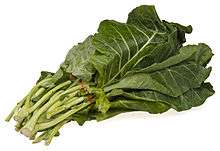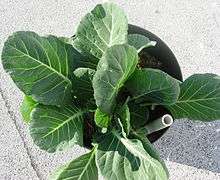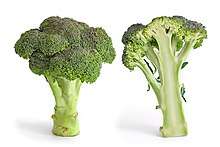Collard greens
| Collard greens | |
|---|---|
 A bundle of collard greens | |
| Species | Brassica oleracea |
| Cultivar group | Acephala Group |
| Origin | Greece |
| Cultivar group members | Many; see text. |

Collard greens (collards) describes certain loose-leafed cultivars of Brassica oleracea, the same species as many common vegetables, including cabbage (Capitata Group) and broccoli (Botrytis Group). Collard greens are part of the Acephala Group of the species, which includes kale and spring greens. They are in the same cultivar group owing to their genetic similarity. The name "collard" comes from the word "colewort" (the wild cabbage plant).[1][2]
The plants are grown for their large, dark-colored, edible leaves and as a garden ornamental, mainly in Brazil, Portugal, the southern United States, many parts of Africa, the Balkans, northern Spain, and Kashmir.
Description
The cultivar group name Acephala ("without a head" in Greek) refers to the fact that this variety of B. oleracea does not have the close-knit core of leaves (a "head") like cabbage does.[3] The plant is a biennial where winter frost occurs, and a perennial in colder regions. It is also moderately sensitive to salinity. It has an upright stalk, often growing up to two feet tall. The plant is very similar to kale. Popular cultivars of collard greens include 'Georgia Southern', 'Morris Heading', 'Butter Collard' (couve manteiga), couve tronchuda, and Groninger Blauw.
Cultivation and storage
The plant is commercially cultivated for its thick, slightly bitter, edible leaves. They are available year-round, but are tastier and more nutritious in the cold months, after the first frost.[4] For best texture, the leaves are picked before they reach their maximum size, at which stage they are thicker and are cooked differently from the new leaves. Age does not affect flavor. Flavor and texture also depend on the cultivar; the couve manteiga and couve tronchuda are especially appreciated in Brazil and Portugal.
Fresh collard leaves can be stored for up to 10 days if refrigerated to just above freezing (1 °C) at high humidity (>95%). In domestic refrigerators, fresh collard leaves can be stored for about three days. Once cooked, they can be frozen and stored for greater lengths of time.
Nutritional information
| Nutritional value per 100 g (3.5 oz) | |
|---|---|
| Energy | 137 kJ (33 kcal) |
|
5.6 g | |
| Sugars | 0.4 g |
| Dietary fiber | 4 g |
|
0.7 | |
|
2.7 g | |
| Vitamins | Quantity %DV† |
| Vitamin A equiv. |
48% 380 μg42% 4513 μg6197 μg |
| Thiamine (B1) |
3% 0.04 mg |
| Riboflavin (B2) |
9% 0.11 mg |
| Niacin (B3) |
4% 0.58 mg |
| Pantothenic acid (B5) |
4% 0.22 mg |
| Vitamin B6 |
10% 0.13 mg |
| Folate (B9) |
4% 16 μg |
| Vitamin C |
22% 18 mg |
| Vitamin E |
6% 0.9 mg |
| Vitamin K |
388% 407 μg |
| Minerals | Quantity %DV† |
| Calcium |
14% 141 mg |
| Iron |
9% 1.13 mg |
| Magnesium |
6% 21 mg |
| Manganese |
24% 0.51 mg |
| Phosphorus |
5% 32 mg |
| Potassium |
2% 117 mg |
| Sodium |
1% 15 mg |
| Zinc |
2% 0.23 mg |
| Other constituents | Quantity |
| Water | 90.2 g |
|
| |
| |
|
†Percentages are roughly approximated using US recommendations for adults. Source: USDA Nutrient Database | |
Like kale, collard greens contain substantial amounts of vitamin K (388% of the Daily Value, DV) in a 100 gram serving. Collard greens are rich sources (20% or more of DV) of vitamin A, vitamin C, and manganese, and moderate sources of calcium and vitamin B6. A 100 gram serving of cooked collard greens provides 33 calories, is 90% water, 3% protein, 6% carbohydrates and less than 1% fat.
Culinary use
Collard greens have been eaten for at least 2000 years, with evidence showing that the ancient Greeks cultivated several types of collard greens, as well as kale.[5]
Southern United States
Collard greens are a staple vegetable in Southern U.S. cuisine.[6] They are often prepared with other similar green leaf vegetables, such as kale, turnip greens, spinach, and mustard greens in the dish called "mixed greens". Typical seasonings when cooking collards are smoked and salted meats (ham hocks, smoked turkey drumsticks, smoked turkey necks, pork neckbones, fatback or other fatty meat), diced onions, vinegar, salt, and black pepper, white pepper, or crushed red pepper, and some cooks add a small amount of sugar. Traditionally, collards are eaten on New Year's Day, along with black-eyed peas or field peas and cornbread, to ensure wealth in the coming year.[6] Cornbread is used to soak up the "pot liquor", a nutrient-rich collard broth. Collard greens may also be thinly sliced and fermented to make a collard sauerkraut that is often cooked with flat dumplings.
East Africa
Collard greens are known as sukuma wiki in Tanzania and Kenya. Sukuma wiki is mainly lightly sauteed in oil until tender, flavoured with onions and seasoned with salt, and served either as the main accompaniment or as a side dish with the preferred meat (fish, chicken, beef, or pork). In Congo, Tanzania and Kenya (East Africa), thinly sliced collard greens are the main accompaniments of a popular dish known as sima or ugali (a maize flour cake).
Zimbabwe
In Zimbabwe collard greens are known as mbida. Due to the climate, mbida thrives under almost all conditions, with most people growing it in their gardens. It is commonly eaten with Sadza (ugali in West & East Africa, pap in South Africa and polenta in Italy) as part of the staple food [7]. Mbida is normally wilted in boiling water before being fried and combined with sautéd onions and/or tomato. Some (more traditionally, the Shona people) add beef, pork and other meat to the mbida mix for a type of stew [8]. Most people eat mbida on a regular basis in Zimbabwe as it is economical and as previously mentioned, can be grown with little to no effort in ones own garden.
UK
In the UK these leaves are sold as Spring Greens and used just like cabbage. The UK market is not large, as most British prefer to buy a cabbage and pull leaves off as required and prefer the light bright leaves in the cabbage heart.,[9]
Brazil and Portugal

In Portuguese and Brazilian cuisine, collard greens (or couve) is a common accompaniment to fish and meat dishes. They make up a standard side dish for feijoada, a popular pork and beans-style stew.[10]
Thinly sliced collard greens are also a main part of the popular Portuguese soup, caldo verde ("green broth"). For this broth, the leaves are sliced into strips, 2–3 millimetres (0.079–0.118 in) wide (sometimes by a grocer or market vendor using a special hand-cranked slicer) and added to the other ingredients 15 minutes before it is served.
Kashmir
In Kashmir Valley, collard greens (haakh) are included in most of the meals, and both the leaves and roots are consumed. Leaves in the bud are harvested by pinching in early spring when the dormant buds sprout and give out tender leaves. Also, seedlings after 35–40 days (3,000–3,500 ks), as well as mature plants, are pulled out along with roots from thickly sown beds. When the extending stem bears alternate leaves in quick succession during the growing season, older leaves are harvested periodically. Before autumn, the apical portion of the stem is removed along with the whorled leaves.
The tastiest variety and most favorite in Kashmir is Khanyari haakh. The small collard green leaves of spring are known as kaanyil haakh. In winter the frost ridden fresh leaves are known to taste better. A common dish within the Kashmiri Hindu community is haak rus, a soup of whole collard leaves cooked in water, salt and oil along with many other spices, and usually eaten with rice. Collard leaves are also cooked with meat (maaz ti haakh), fish (haakh gaade) or cheese (tsaaman ti haakh).
Pests
The sting nematode Belonolaimus gracilis and the awl nematode, Dolichodorus spp. are both ectoparasites that can injure collard. Root symptoms include, stubby or coarse roots that are dark at the tips. Shoot symptoms include, stunted growth, premature wilting and chlorosis (Nguyen and Smart, 1975). Another species of the sting worm: Belonolaimus longicaudatus is a pest of collards in Georgia and North Carolina (Robbins and Barker, 1973). B. longicaudatus is devastating to seedlings and transplants. As few as three nematodes per 100g of soil when transplanting can cause significant yield losses on susceptible plants. They are most common in sandy soils (Noling, 2012).
The stubby root nematodes Trichodorus and Paratrichodorus attach and feed near the tip of the tap roots of collard greens. The damage caused prevents proper root elongation leading to tight mats that could appear swollen, therefore resulting in a "stubby root" (Noling, 2012).
Several species of the root knot nematode Meloidogyne spp. are hosted by collards these include: (M. javanica, M. incognita and M. arenaria. Second stage juveniles attack the plant and settle in the roots. However, infestation seems to occur at lower populations compared to other cruciferous plants. Root symptoms include deformation (galls) and injury that prevent proper water and nutrient uptake. This could eventually lead to stunting, wilting and chlorosis of the shoots (Crow and Dunn, 2012).
The false root knot nematode Nacobbus aberrans has a wide host range of up to 84 species including many weeds. On Brassicas it has been reported in several states including Nebraska, Wyoming, Utah, Colorado, Montana, South Dakota, Kansas (Manzanilla- López et al., 2002). As a pest of collards, the degree of damage is dependent upon the nematode population in the soil.
See also
References
- ↑ "collard". Oxford English Dictionary (3rd ed.). Oxford University Press. September 2005. (Subscription or UK public library membership required.)
- ↑ "Greeks and Romans Grew Kale and Collards". Texas A&M Agricultural Extension. Retrieved 2018-04-02.
- ↑ "Brassica oleracea var. acephala". Floridata. 2007-02-06. Retrieved 2012-07-26.
- ↑ "Birney Imes: Amazing collards – The Dispatch". Cdispatch.com. 2012-07-21. Retrieved 2012-07-26.
- ↑ "Greeks and Romans Grew Kale and Collards | Archives | Aggie Horticulture". Aggie-horticulture.tamu.edu. Retrieved 2012-07-26.
- 1 2 Vitrano A (2011-01-01). "Dine wise on New Year's Day, Certain foods could bring you luck". South Carolina NOW. Archived from the original on 2013-02-01. Retrieved 2012-07-26.
- ↑ http://www.foodbycountry.com/Spain-to-Zimbabwe-Cumulative-Index/Zimbabwe.html
- ↑ https://www.zimbokitchen.com/pork-bones-haifiridzi/
- ↑ Spring greens
- ↑ "How to Make Feijoada, Brazil's National Dish, Including a Recipe From Emeril Lagasse by Shaylyn Esposito". Smithsonian.com. 2014-06-13.
External links

